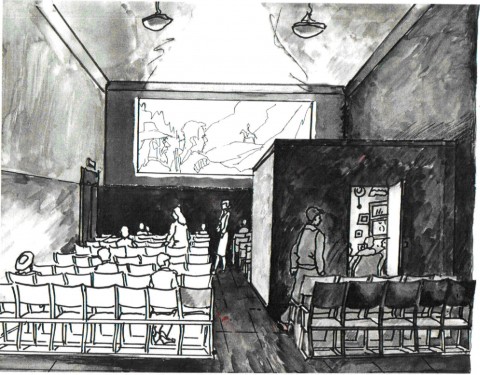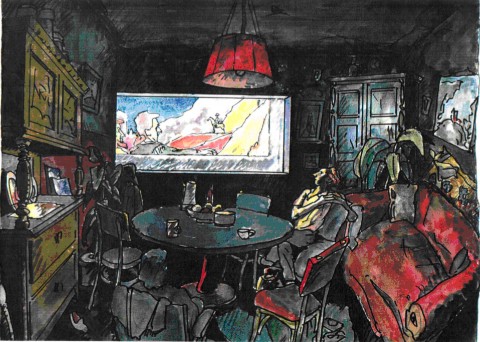Ilya told the Financial Times that it is a contemplation of the 'stupid mentality' of romanticising the past. Kabakov himself grew up in that period - he was born in 1933 - and what is certain is that life under Stalin was no utopia. The Great Famine of 1932-1933 is estimated to have killed approximately nine million people; so much for those joyful peasants.
This mocking of the non-utopian past links, in my mind, with the idea of exile, whether voluntary or forced. I have interviewed the Kabakovs a couple of times, and what comes across very clearly is that while Emilia has become American - in fact, she deliberately chose America over, say, the UK, because one can become American quickly, unlike here where it takes more than one generation to be thought British - Ilya is caught somewhere between Russia and the rest of the world. Emilia is his conduit between work and everything else. I have visited their house on Long Island, and made the mistake of suggesting that it was Russian in feel - "It is not Russian, it is American," Emilia told me very firmly, and then explained that anyone who had left had to cut all ties with the past - otherwise "you wouldn't survive. It would be unbearable." It is a message that comes across clearly in a poem by Vladimir Nabokov, To Russia, which I have to write out in full because it is just so beautiful:
Will you leave me alone? I implore you
Dusk is ghastly. Life's noises subside.
I am helpless. And I am dying
Of the blind touch of your whelming tide.
He who freely abandons his country
On the heights to bewail it is free
But now I am down in the valley
and now do not come close to me.
I'm prepared to lie hidden forever
and to live without a name. I'm prepared
Lest we only in dreams come together
all conceivable dreams to forswear.
To be drained of my blood, to be crippled,
To have done with the books I most love
for the first available idiom
to exchange all I have: my own tongue.
But for that, through the tears, oh Russia,
through the grass of two far-parted tombs
through the birch trees tremulous macules
through all that sustained me since youth
with your blind eyes, your dear eyes, cease looking
at me, oh, pity my soul,
do not rummage around in this coalpit
do not grope for my life in this hole
because years have gone by and centuries
and for sufferings, sorrow, and shame,
too late - there is no one to pardon
and no one to carry the blame.
It is the first thing that Nabokov wrote after leaving Russia, and it literally sends shivers down my spine every time I read it, because I just can't imagine how awful it must be never to be able to go home again. And were I ever to find myself marooned on a desert island, I think that might be the poem that I would most value. (I don't know what is going on with the upper case/ lower case beginnings of lines in the version that I found to put on here, incidentally. I am aware that it all looks a bit odd.) Of course, the Kabakovs are able to go back to Russia now, and do so, regularly, but it is a Russia that has changed so much, and so fast, that it is, in Emilia's words, unrecognisable from the Russia that they left - so in a sense, they still can't ever really go home.
There is no doubt that Ilya Kabakov is the most important living Russian artist - he's the father of Moscow Conceptualism - and the most expensive. Roman Abramovich and Dasha Zhukova reportedly paid $60 million for a collection of Ilya Kabakov's early work (the Kabakovs haven't always co-signed everything; although they've known each other all their lives - they're cousins - the didn't start working together until Ilya left the Soviet Union for the US in 1988, Emilia had left 1973, really thinking that she could never go back. It was Ilya who drove her to the station, he told her he loved her en route, they finally married in 1992.) There are examples of his work from the 80s hanging in the Saatchi Gallery's Breaking the Ice: Moscow Art 1960s - 1980s, which is a great exhibition focusing on a period that I am fascinated by. I can not possibly sumarise why I am fascinated by it in a matter of pararaphs, but there's a very good book on the subject - The Irony Tower; Soviet Art in a Time of Political Glasnost by Andrew Solomon. It's truly gripping, and certainly sets the scene for what went before The Happiest Man.
The Happiest Man is at Ambika P3, 35 Marylebone Road, NW1 until the 21st April.


